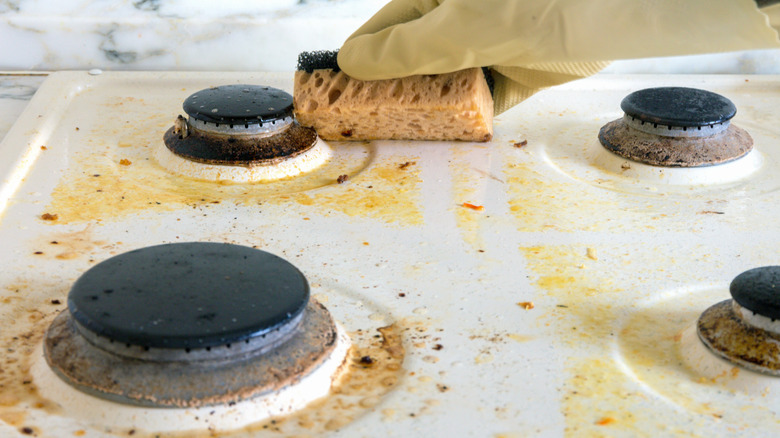The Easy Plastic Wrap Hack That Will Leave Your Stovetop Sparkling
We've all been there (and some of us still are): the point where your stovetop is more of an eyesore due to burn marks and stains than it is a beautiful centerpiece tying your kitchen together. As we've touched on before, it's never wise to cut corners by lining your stovetop with aluminum foil, as that can often make a mess rather than prevent one. So, what can you do to prevent grease stains from building up? Unfortunately, your best option is to accept that stovetop messes are a fact of life.
Instead of hoping for a miracle, what you'll have to do is find a better method of cleaning up the inevitable nastiness that forms over time. The problem is that it often takes more than a few sprays of Lysol and some elbow grease to get those pesky grease stains off the surface of your stove. Thankfully, content creator Auri Kananen offers a game-changing cleaning hack to do away with those impossible-to-clean stovetops.
The trick is simple. All it takes is some oven cleaner, plastic wrap, a coarse sponge or a scouring pad, and patience. The only downside: Your stovetop may be out of commission for longer than you are accustomed to.
How to use plastic wrap for a sparkling stovetop
All you have to do is spray oven cleaner across the surface of the stove, focusing on areas with the most stains and burn marks (usually the areas surrounding the burners). You then stretch out some plastic wrap and cover the entire area, pressing down so that it adheres to the edges and curves of the stove. After that, you'll have to give the cleaner around 24 hours to work its magic, according to the content creator. (Be sure to clean your air fryer beforehand so you can use it while your stove is on vacation.)
Once 24 hours have passed, you can remove the plastic wrap, at which point you'll likely see puddles of icky goop pooling on your stovetop. All that's left after that is wiping it all off with your sponge or scouring pad, and ta-da; a clean stove! This trick is especially useful on lighter-toned stovetops, as oil and grease stains will appear more prominent than on darker-toned surfaces. But either way, this heavy-duty cleaning method should work all the same.
